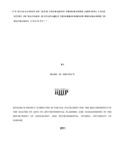| dc.contributor.author | Ndungu, Mary W | |
| dc.date.accessioned | 2015-03-24T06:47:49Z | |
| dc.date.available | 2015-03-24T06:47:49Z | |
| dc.date.issued | 2012 | |
| dc.identifier.uri | http://hdl.handle.net/11295/81562 | |
| dc.description.abstract | Nearly all future population growth will be in the cities and towns of the developing
world. Which are growing at unprecedented rate: soon the rural population will be less
than the urban, while the number of urban dwellers living in poverty is increasing day by
day. As a result of this, the demand for more urban land, shelter, infrastructure, social
facilities, and employment has exceeded supply as evident in the current state of urban
sprawl and proliferation of slums and squatter settlement. In response to this, the
government initiated the Kenya Slum Upgrading Programme with one of its components
being Sustainable Neighbourhood Programme (SNP). The programme aims at improving
the lives of people living and working in the slums and informal settlements in all urban
areas of Kenya. The study evaluates the state of the low income housing in Mavoko,
determines the potential of the SNP in improving the living conditions of beneficiary
population, explores the means used by the programme to achieve its goals; challenges
facing its implementation and most important, the lessons learnt in the implementation of
the programme. It further provides recommendations and proposes strategies for
implementation of the programme. Interviews, focused group discussion, photography
and observation were used to collect data which was analyzed using qualitative and
quantitative methods. The data was processed to create data code book which was used to
create digital project data base file ,first in Microsoft excel spreadsheet which was then
exported into SPSS and save as a data file. The data was then subjected to analysis
procedure starting with descriptive frequency and percentages provide sample data
distribution tendencies. Data was presented in graphs, pie charts and photographs. The
study established that majority of the residents in the area were tenants and squatters and
hence lacked the motivation to redevelop the existing poor housing structures. Given the
slum dwellers' low income, expenditure, savings and assets owned, the study established
that the programme had the potential to improve the residents' standard of living. Civic
education, strengthening of civil societies, community-government partnership, and
formation of housing cooperatives and development of mixed housing arc some of the
strategies being used in the SNP. However, the programme is constrained by poor
communication systems, poor management of housing cooperatives, fluctuating prices of
building materials and inadequate finance. The study recommends development of an
iv
cflcctive communication system, training and monitoring of housing cooperatives'
officials, establishment of price controls to cushion the poor living in the slums and
initiation of income generating activities to support the project by the government. | |
| dc.description.abstract | Nearly all future population growth will be in the cities and towns of the developing
world. Which are growing at unprecedented rate: soon the rural population will be less
than the urban, while the number of urban dwellers living in poverty is increasing day by
day. As a result of this, the demand for more urban land, shelter, infrastructure, social
facilities, and employment has exceeded supply as evident in the current state of urban
sprawl and proliferation of slums and squatter settlement. In response to this, the
government initiated the Kenya Slum Upgrading Programme with one of its components
being Sustainable Neighbourhood Programme (SNP). The programme aims at improving
the lives of people living and working in the slums and informal settlements in all urban
areas of Kenya. The study evaluates the state of the low income housing in Mavoko,
determines the potential of the SNP in improving the living conditions of beneficiary
population, explores the means used by the programme to achieve its goals; challenges
facing its implementation and most important, the lessons learnt in the implementation of
the programme. It further provides recommendations and proposes strategies for
implementation of the programme. Interviews, focused group discussion, photography
and observation were used to collect data which was analyzed using qualitative and
quantitative methods. The data was processed to create data code book which was used to
create digital project data base file ,first in Microsoft excel spreadsheet which was then
exported into SPSS and save as a data file. The data was then subjected to analysis
procedure starting with descriptive frequency and percentages provide sample data
distribution tendencies. Data was presented in graphs, pie charts and photographs. The
study established that majority of the residents in the area were tenants and squatters and
hence lacked the motivation to redevelop the existing poor housing structures. Given the
slum dwellers' low income, expenditure, savings and assets owned, the study established
that the programme had the potential to improve the residents' standard of living. Civic
education, strengthening of civil societies, community-government partnership, and
formation of housing cooperatives and development of mixed housing arc some of the
strategies being used in the SNP. However, the programme is constrained by poor
communication systems, poor management of housing cooperatives, fluctuating prices of
building materials and inadequate finance. The study recommends development of an
cflcctive communication system, training and monitoring of housing cooperatives'
officials, establishment of price controls to cushion the poor living in the slums and
initiation of income generating activities to support the project by the government. | |
| dc.language.iso | en | en_US |
| dc.publisher | University of Nairobi | en_US |
| dc.title | An evaluation of Kenya Slum Upgrading Programme (KENSUP): A case study of Mavoko Sustainable Neighbourhood Programme in Machakos County, Kenya | en_US |
| dc.type | Thesis | en_US |
| dc.type.material | es | en_US |

